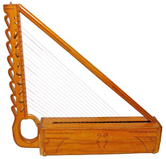:: Changi
Svanetian Changi
The Changi is a ancient Georgian traditional multi-string instrument. Changi is harp-like instrument has 6, 7, 9 (or more) strings. The strings are made of nylon and they have different length. Nowadays, Changi is preserved only in one region of Georgia - Svaneti (North-Western mountainous part). Changi consists of two main parts: an angled body and supplementary elements, which are represented by keys (1) and tuners (2). The body consists of horizontal and vertical parts.
The horizontal part the resonator - is made out of a long hollowed tree and has the shape of semi-cylindrical form with a right angle at one end, using two pieces of wood. The vertical board is fitted into the horizontal board. Plate of about 4mm with a small curvature in the middle is nailed onto it. The plate has 6 notches for buttons (1) to fasten the strings, they are fastened at the same distance from the sides of the resonator. The vertical part is straight and flat. It has holes for the tuners (2). The tip of the vertical part is inserted into the horizontal part forming a right angle. The six (sometimes seven) strings are connected to the tuning keys at the top of the changi, and pulled through the bottom, vertical section. On both parts small wooden sticks are nailed parallel to the strings.

Changi
The Changi frame is mainly made of softwood, usually from coniferous trees, but sometimes pine-tree is used. The Changi has 6 or 7 strings. The tune of a six-string Changi is “fa”, “sol”, “la”, “si”, “do”, “re”. The seven-string Changi has the same tune but its scale begins with “mi”. Special proportions are kept by the instrument makers when designing Changi. It is mostly played by women and is generally used for accompaniment. Solo songs are often accompanied with it. But melodies performed on this instrument represent the transcription of Svanetian national “Saperkhulo” (a dance) melodies not the original instrumental music. Only one Changi is used while accompanying solo melodies. Nevertheless, combining “Chuniri” and “Changi” into ensemble was quite frequent.
Tuning of the six-stringed changi: f-g-a-h-c1-d1;
Tuning of the seven-stringed changi:s e-f-g-a-h-c1-d1;
The Svanetian Changi is one of the Caucasus region’s oldest stringed instruments, and has been played in Georgia since the 4th century. It was considered to be the instrument of “sorrow”. According to the sayings, it was often played to comfort a person in his grief. There is a legend connected with Changi that tells us the story of an old man whose son was killed in a war and who found an expression of his grief in a sad melody of Changi. Changi in Svanetian language is also called “Shimekvshe” that means a broken arm.
Changi is closely related to other harplike instruments of western Asia, and is thought to have been developed during the same era as the Sumerian harp. “Shumerians” are the most ancient nations, who lived in western Asia and are thought to have been closely connected with our ancestors with ties of kinship has the similar instrument that looks like the Svanetian harp. There is a supposition about the origin of Changi, according which it must have been originated from a bow. This weapon is not a particular nation’s invention. Thus, Changi could have been invented independently in different nations. The changi is also quite similar and likely related to harps from Egypt, Babylon, Iran, China, and Greece.
Go to top

